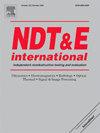基于三维空间采样漏磁信号的桥梁电缆断线定量评价方法
IF 4.5
2区 材料科学
Q1 MATERIALS SCIENCE, CHARACTERIZATION & TESTING
引用次数: 0
摘要
桥梁电缆作为索桥的关键承重部件,极易因腐蚀和疲劳造成断线。准确定量地评估这类损伤对保证结构安全至关重要。提出了一种利用三维空间漏磁信号定量识别断线数量的新方法。该方法首先获取三维空间漏磁场,生成漏磁信号的三维阵列进行计算分析。然后提取两类特征。第一个是全局特征,定义为测量的三维空间MFL信号与无缺陷参考信号之间的L1范数距离(L1D)。二是局部特征,由多尺度波形特征组成特征阵列。采用多线性主成分分析(MPCA)压缩多尺度波形特征阵列,减少计算冗余。然后将压缩的特征阵列引入弹性网络约束回归(ENCR)模型来预测缺陷宽度。断线数最终计算为总L1D值与预测单线宽度对应的L1D值之比。对于给定的断线宽度,L1D在断线数方面表现出线性叠加,拟合优度值超过0.999,可以实现比例量化。通过PES7-127电缆(127根直径为7mm的导线)的仿真和实验验证了该方法的有效性。模拟在不同宽度和分布的断丝计数中达到100%的准确性,而实验结果验证了≤4条断丝缺陷的量化精度为100%(在±1丝的公差范围内)。这种性能是使用只有30个样本的训练数据集获得的。本研究为桥梁缆索评估提供了一种实用有效的方法。本文章由计算机程序翻译,如有差异,请以英文原文为准。
A quantitative evaluation method for broken wires in bridge cables using 3D spatially sampled magnetic flux leakage signals
Bridge cables, which serve as critical load-bearing components in cable-supported bridges, are highly susceptible to broken wires caused by corrosion and fatigue. Accurate quantitative evaluation of this type of damage is essential to ensure structural safety. This study presents a novel quantitative evaluation method for identifying the number of broken wires by employing the magnetic flux leakage (MFL) signal in three-dimensional (3D) space. The method first acquires the 3D spatial magnetic leakage field and generates 3D arrays of MFL signals for computational analysis. It then extracts two categories of features. The first is the global feature, defined as the L1 norm distance (L1D) between the measured 3D spatial MFL signal and the defect-free reference signal. The second is the local feature, consisting of multi-scale waveform features organized as a feature array. The multi-scale waveform feature arrays are compressed using Multilinear Principal Component Analysis (MPCA) to reduce computational redundancy. The compressed feature arrays are then introduced into the Elastic Net-Constrained Regression (ENCR) model to predict defect width. The number of broken wires is ultimately calculated as the ratio of the total L1D value to the L1D value corresponding to the predicted width of a single wire. For a given broken wire width, the L1D demonstrates linear superposition with respect to the number of broken wires, with goodness-of-fit values exceeding 0.999, enabling proportional quantification. Validation through simulations and experiments on PES7-127 cables (127 wires of 7 mm diameter) confirms the method's effectiveness. The simulations achieved 100 % accuracy in counting broken wires across varying widths and distributions, while experimental results verified 100 % quantification accuracy (within a tolerance of ±1 wire) for defects involving ≤4 broken wires. This performance is obtained using a training dataset of only 30 samples. This study provides a practical and efficient approach for bridge cable assessment.
求助全文
通过发布文献求助,成功后即可免费获取论文全文。
去求助
来源期刊

Ndt & E International
工程技术-材料科学:表征与测试
CiteScore
7.20
自引率
9.50%
发文量
121
审稿时长
55 days
期刊介绍:
NDT&E international publishes peer-reviewed results of original research and development in all categories of the fields of nondestructive testing and evaluation including ultrasonics, electromagnetics, radiography, optical and thermal methods. In addition to traditional NDE topics, the emerging technology area of inspection of civil structures and materials is also emphasized. The journal publishes original papers on research and development of new inspection techniques and methods, as well as on novel and innovative applications of established methods. Papers on NDE sensors and their applications both for inspection and process control, as well as papers describing novel NDE systems for structural health monitoring and their performance in industrial settings are also considered. Other regular features include international news, new equipment and a calendar of forthcoming worldwide meetings. This journal is listed in Current Contents.
 求助内容:
求助内容: 应助结果提醒方式:
应助结果提醒方式:


